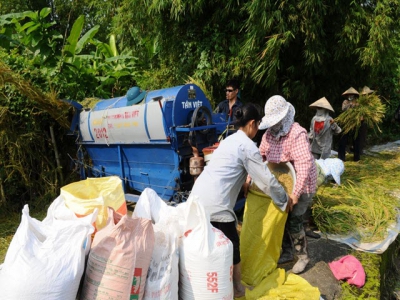Cooperatives bear fruit, linking production with busines

Cooperatives play an important role in helping farmers link up with businesses and participate in the value chain of agricultural products, but targeted support mechanisms and policies are required to bring this potential into full play.
The importance of cooperatives For example, the northwestern province of Son La has 345 agricultural cooperatives, 200 of them specializing in fruit production. The cooperative model has helped make Son La the largest fruit-producing region in the country by transforming its crop structure and linking production development. The Moc Chau Passion Fruit Cooperative in Sub-zone 104, Moc Chau Town is a telling example, providing support in seedlings, science and technology and sales. The cooperative mainly grows passion fruit on an area of nearly 300ha and links 270 households in Moc Chau, Van Ho, Thuan Chau and Mai Chau districts.
According to Hoang Van Chap, a member of the Moc Chau Passion Fruit Cooperative, the cooperative has linked households to develop passion fruit planting. In addition, farmers participating in the cooperative are trained in production organization according to safety standards and product consumption. As a result, their passion fruit trees have high yield and quality, with each hectare of fruit harvested bringing in about VND200 million. The cooperative is also the “matchmaker” that connects farmers with businesses. About 37 enterprises in Son La currently invest in fruit processing factories, reflecting the benefits of organizing agricultural production through cooperatives in order to link farmers with business and form agricultural product value chains.
According to the Department of Cooperatives and Rural Development under the Ministry of Agriculture and Rural Development (MARD), by the end of 2020, over 17,000 agricultural cooperatives and 57 agricultural cooperatives unions operate in Vietnam. Among these, 3,913 cooperatives link enterprises that produce and consume agricultural products, accounting for 22.8 percent. The cooperatives help organize agricultural production according to standards and regulations, develop commodity production areas, promote links among players in the value chain, and receive and disseminate State support policies.
According to Nguyen Thi Luyen, Deputy Head of the Enterprise Reform and Development Research Department of the Central Institute for Economic Management (CIEM), in the context of deep international integration and free trade agreements, promoting production and business links along the value chain is gradually becoming the optimal production method for sustainable development. They help farmers produce more competitive products, reducing production costs.
Flexible support policies Dr. Pham Minh Dien, Deputy Head of the Policy and Cooperative Development Department under the Vietnam Cooperative Alliance (VCA), said that in the 2015-2020 period, the State has issued many policies to support cooperatives, six of them general support policies, two tax and fee incentives, five preferential policies and additional specific support for agricultural cooperatives.
Up to now, 19,000 cooperatives have enjoyed the State's support policy with a total budget of more than VND3.43 trillion. On average, more than 3,000 cooperatives enjoy preferential policies annually, accounting for 16 percent of the total number of cooperatives nationwide. In order for cooperatives to develop well, flexible support policies are required. These must be practical, suitable to the needs and characteristics of each development period. Support funding must be timely and appropriate to promote the active and autonomous role of the cooperative, Dien added.
The Prime Minister’s Draft Decision approving the 2021-2030 collective economic development strategy has set a target of almost tripling the number of cooperatives to 45,000 and having 140,000 cooperative groups and 340 cooperative unions by 2030. Under this scenario, some two million people would be cooperative group members and eight million cooperative members. The decision also calls for the application of high technology in the agricultural sector in order to have over 5,000 cooperatives applying high technology in production and consumption of agricultural products by 2030.
Có thể bạn quan tâm
Phần mềm

Phối trộn thức ăn chăn nuôi

Pha dung dịch thủy canh

Định mức cho tôm ăn

Phối trộn phân bón NPK

Xác định tỷ lệ tôm sống

Chuyển đổi đơn vị phân bón

Xác định công suất sục khí

Chuyển đổi đơn vị tôm

Tính diện tích nhà kính

Tính thể tích ao hồ



 Vietnamese farmers sell farm produce via smartphones
Vietnamese farmers sell farm produce via smartphones  Kiên Giang sees positive results from restructuring agriculture,…
Kiên Giang sees positive results from restructuring agriculture,…